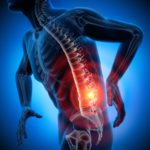



Case:
- A 68 year old ex professional footballer presented with severe right foot, right knee and right hip pain.
- The pain had been ongoing since the patient had his right knee replaced 2 years previously and although the knee’s range of movement was much better and the knee joint itself as vastly improved, it had created another set of painful problems.
- The patient post op was asked to perform the obligatory climbing up and down 4 steps within the hospital before being released.
- The patient didn’t receive any post op rehabilitation treatment.
- The patient was unable to flex the right knee and the knee pain had gone up into his hip and down into his foot as his gait had been altered and was effectively hobbling around putting most of this weight onto his left leg.
- The osteopathic approach that was taken was to enable the knee to flex fully, realign the hip, knee and foot so that the weight is spread evenly throughout the 3 joints.
- After 3 osteopathic treatments the patient was symptom and pain free, able to fully flex his right knee and was able to enjoy the full benefits of having a severely arthritic replaced. He no longer had pain in his right foot, right knee or right hip.
Osteopathy Before and/or After Surgery
Many life events such as traumas, illness and surgery can affect the body in ways that compromise its ability to adapt and compensate. The trauma of a fall or injury can deeply affect your body even though a hospital visit is not needed.
Although surgery may address the cause of your problem, it is not the end of your treatment. The act of surgery itself, however minimally invasive, still causes damage that like any other injury needs treatment.
If you know that you have a surgery coming up, for example a hip or knee replacement, we can offer pre-habilitation.
Pre-habilitation:
This is where we help you and your body to be as fit as possible, ready for surgery. You may already notice that you are walking differently from side to side, using your body differently.
You may be suffering with aches and pains around the body as it tries to adjust to a new way of moving. This is most likely a way which reduces the pain that you are experiencing, or the only way that your body can now move due to loss of range of movement.
Keeping your body moving as well as it can, and keeping the muscles strong, means that you should rehabilitate quicker after your surgery. This also reduces the effect on the rest of your body.
For example you may need a hip replacement, but may be experiencing pain in the knee. This is because the hip is unable to rotate properly so your knee joint is trying to make that movement, which it is not designed to do. It is therefore stretching the tissues surrounding the joint and causing inflammation.
By keeping your hip as mobile as possible and relaxing the thigh muscles, we can ease the pain in the knee joint and stop the knee joint possibly becoming injured. Because you cannot walk easily on that side, you may find that you are limping and putting more weight onto the other side of the body. You may also be using walking aids which are creating tension in your upper back and arms.
Post Surgery Rehabilitation:
We can help you get back your pre-surgery mobility and life style. You may have had elective surgery, or it may be as a result of a trauma/accident.
Often patients are uncomfortable after surgery, due to the surgery itself, the hospital bed and from being immobilised for a period of time. Gentle osteopathic treatment, encouragement and exercises to get you back to normal activity will be provided. This can all be done as soon as you are well and comfortable enough following your surgery and return to home.
Our experienced therapists can help assess your current ability and develop a personalised treatment plan that not only takes account of your surgery wound, but actively encourages quality, functional healing. We can build on the guidelines for rehabilitation given by surgeon and treat you regularly post-surgery to achieve the best possible recovery in the shortest possible time.
The issues that may affect you after surgery will vary depending on the original condition that was treated and how invasive the surgery was. An important factor will be your general condition before surgery takes place – but we can help that with pre-habilitation.
If you are using crutches or walking aids you may need treatment for your upper back and arms. If parts of you have been immobilised following a fracture for example, we can help your movement, strength and control return.
The ultimate goal will be to help you return to the activities and sports that you were performing prior to the surgery. The time frame for rehabilitation and return to these activities will depend the injury, surgery performed and an individual’s presentation.
As osteopaths we can:
- Provide hands on manual therapy and other techniques such as medical acupuncture to help restore normal range of movement and biomechanics to the body.
- Give circulation exercises if your surgery leaves you sitting of lying down a lot.
- Give strengthening exercises, to regain functional strength and improve joint stability.
- Give advice on activity modification to safely mobilise during recovery.
- Give balance exercises, to improve proprioception and joint stability.
- Give advice on the use of mobility aids, including crutches, strikes and walking frames.
As your body recovers from surgery it may try to compensate for the injury by changing the way you move or rest.
Unfortunately this can lead to poor posture and movement habits that may cause further injury if not addressed.